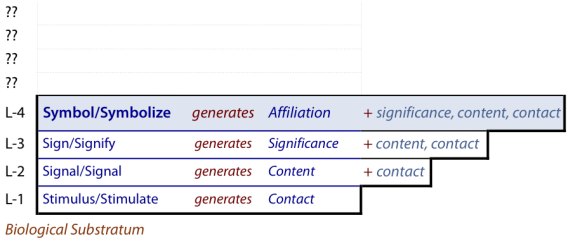Symbols: Cross any Boundary at L4
Function & Name
is the THEE-name for: «something in one domain of discourse, which represents and evokes ideas from one or more different domain of discourse.»
can ramify and connote very widely which naturally affects their significance and content in any message. But this is effectively controlled by socialization within a group, and symbols express this affiliation.
The receiver may view certain things as in the same manner.

Properties
The expression and understanding of depend on the sender (or user) of the symbol and recipient (or noticer) of a sharing an experience of living within a particular culture or an enduring group (large or small).
are conventional. They are indirect and connote widely, but they are not experienced as confusing, surprising or ambiguous. Removing all boundaries to the transfer of significance between things, in any domain of life, creates an enormous potential for confusion. This is avoided, however, by cultural standardization.
express the sender's or recipient's group affiliation. They are the royal road to making sense of a group's psychosocial reality. Once you know them thoroughly, you know the group and may well be treated as part of the group. This likely applies to groups of all sorts that endure: from a family, through associations, and up to nations.
We can say of a person "He slept like a log" while we do not say "He slept like the pyamids" or "like a sandbank"
In French, a trial of strength is referred to as "bras de fer" (literally "arms of iron"): why not "shoulders of granite" or "fists of titanium"? A close race is described as "neck and neck" in English, but in French you are "coude a coude" (i.e. elbow to elbow): why not "eyebrow to eyebrow"?
Symbols are so standardized in a society that they tend to come across as clichés in quality writing. To quote Jack Handy: "How come the dove gets to be the peace symbol? How about the pillow? It has more feathers than the dove, and it doesn't have that dangerous beak".
- Nations may create a musical anthem or fanfare as a .
- Religions use shapes like a crescent or a cross as a .
- Companies may choose a particular image to serve as a .
On beginning to live in a foreign culture, a period of culture-shock invariably ensues. The shock flows from being flooded with new . There is an utter inability to recognize, understand or use the or implicit in those , and handled continuously and effectively by locals. The result is:
- experiences of confusion
- doing the wrong thing
- offending people
- feeling offended
- inability to get even simple things done
- helplessness and frustration
and usually
- over-paying and being exploited.
Phrase books, with their well-meaning sentences, vocabularies and advice, offer almost nothing to help this. However, once you master used by the natives, the shock subsides. After a couple of years, you come to wonder exactly why it was so difficult at the beginning. This applies even if you never master the language. (Remember: we are exploring simple here, not language.)
Errors & Failure
Errors occur for all of the reasons already noted for lower level elements of communication.
In addition, the sender may assume that the recipient is aware of the 's usage, when that is not the case. The recipient of a may also misunderstand due to being from an alien culture, literal-minded or insensitive.
Starting from with as the mechanism, we noted at the that is used to specify a direct learned meaning, then at came the , which suggests a variety of meanings indirectly and within a single topic/domain.
Now with the at , allows for meanings from any topic to be applied to any other topic. In other words, there is a general coverage.
![]() Puzzle: Don't the best writers, like Shakespeare, use new and unexpected symbols?
Puzzle: Don't the best writers, like Shakespeare, use new and unexpected symbols?
- Now move to the 5th level: which typically completes all the actual elements.
Originally posted: 18-Apr-2011; Last updated 25-Sep-2011.